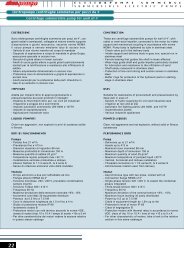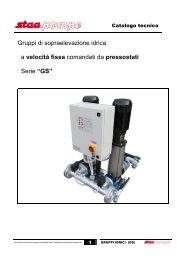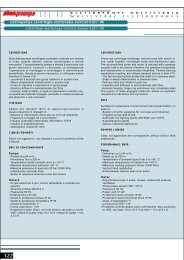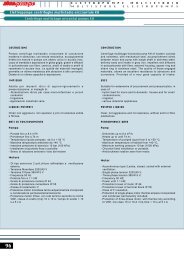Tabella delle perdite di carico nelle tubazioni Pipes charge losses ...
Tabella delle perdite di carico nelle tubazioni Pipes charge losses ...
Tabella delle perdite di carico nelle tubazioni Pipes charge losses ...
You also want an ePaper? Increase the reach of your titles
YUMPU automatically turns print PDFs into web optimized ePapers that Google loves.
152<br />
Dati caratteristici <strong>delle</strong> pompe<br />
Caracteristic data of pomps<br />
Altezza <strong>di</strong> aspirazione NPSH<br />
Definizione <strong>di</strong> NPSH Net Posotiv Suction Head coiè altezza del<br />
battente netto o, in altre e piu chiare parole, è l’altezza (e quin<strong>di</strong><br />
la quantità d’energia) necessaria ed eccedente la tensione <strong>di</strong><br />
vapore (per evitare rischi <strong>di</strong> vaporizzazione) che il liquido deve<br />
possedere all’ingresso della girante per sopprimere ogni rischio <strong>di</strong><br />
cavitazione. Tale fenomeno è accompagnato da turbolenze piu<br />
omeno accentuate con la presenza dei seguenti sintomi:<br />
- Caduta della curva caratteristica portata-prevalenza e del<br />
ren<strong>di</strong>mento della pompa<br />
- Disadescamento della pompa<br />
- Rumori , vibrazioni e martellamento <strong>nelle</strong> <strong>tubazioni</strong> e nella pompa<br />
- Distruzione <strong>delle</strong> parti interne della pompa.<br />
L’NPSH puo intervenire nei calcoli sotto due <strong>di</strong>fferenti forme:<br />
- NPSH richiesto è una caratteristica intrinseca <strong>di</strong> ogni pompa.<br />
Solo tramite prove <strong>di</strong> laboratorio e alcuni parametri si è in grado<br />
<strong>di</strong> determinarlo.in fase <strong>di</strong> calcolo e bene aumentare questi valori<br />
<strong>di</strong> 0.5m come fattore <strong>di</strong> sicurezza.<br />
- NPSH <strong>di</strong>sponibile è invece da parte sua una caratteristica<br />
dell’impianto e <strong>delle</strong> sue necessità in fatto <strong>di</strong> altezza d’aspirazione,<br />
<strong>di</strong> pressione atmosferica, <strong>di</strong> tensione <strong>di</strong> vapore e <strong>di</strong> <strong>per<strong>di</strong>te</strong> <strong>di</strong><br />
<strong>carico</strong>.<br />
È in<strong>di</strong>spensabile per non avere fenomeni <strong>di</strong> cavitazione che L’NPSH<br />
<strong>di</strong>sponibile sia superiore all’NPSH richiesto<br />
Esempio <strong>di</strong> calcolo:<br />
NPSH <strong>di</strong>sponibile = pressione atmosferica – altezza piezometrica<br />
– <strong>per<strong>di</strong>te</strong> <strong>di</strong> <strong>carico</strong> – tensione <strong>di</strong> vapore<br />
Consideriamo una installazione con pompa centrifuga multista<strong>di</strong>o<br />
KV30 04 150<br />
- Prevalenza in mandata H = 67 m<br />
- Portata Q = 700 l/min<br />
- NPSH richiesto 3.8 m + 05 m fattore <strong>di</strong> sicurezza<br />
- Pressione atmosferica = 960mba ,ossia9.78 m<br />
- Altezza peziometrica d’aspirazione H1 = 4 m<br />
- Per<strong>di</strong>te <strong>di</strong> <strong>carico</strong> tubazione + valvole Hj = 0.75 m<br />
- Tensione <strong>di</strong> vapore acqua 12 °C = 0.0143 m<br />
Dai valori numerici <strong>di</strong> cui sopra si ha :<br />
NPSH <strong>di</strong>sp. 9.78 - (4 + 0.75 + 0.0143) = 5.015 m<br />
NPSH richiesto. 3.8 m+ 0.5 m = 4.3 m<br />
Poiche l’NPSH <strong>di</strong>sponibile a valore superiore a l’NPSH richiesto<br />
non dovremmo temere alcun fenomeno <strong>di</strong> cavitazione.<br />
Allegati Enclosures<br />
Intake height NPSH<br />
The definition of NPSH is Net Positive Suction Head, that is the<br />
height of the net head or, in other clearest words, it is the height<br />
(and then the quantity of energy necessary and excee<strong>di</strong>ng vapour<br />
pressure to avoid the risks of vaporization) that the liquid must<br />
possess in the entry of the impeller to suppress every risk of<br />
cavitation. This phenomenon is accompany by the turbulence more<br />
or less accentuated with the presence of the following symptoms:<br />
- falling of the characteristic curve, <strong>di</strong>s<strong>charge</strong>, head and the<br />
efficiency of the pump;<br />
- defusing of the pump;<br />
- noises, vibrations and hammering in the piping and in the pump;<br />
- destruction of the inside parts of the pump.<br />
The NPSH can intervene in the calculation under two <strong>di</strong>fferent<br />
forms:<br />
- NPSH REQUESTED is an intrinsic characteristic of every pump.<br />
Only through testes of laboratory and some parameters we are<br />
able to determine it. In the stage of calculation is better to increase<br />
this values of 0,5 m as safety factor;<br />
- NPSH AVAILABE instead is a characteristic of the system and<br />
of its necessity for the intake height, for atmospheric pressure,<br />
for vapour pressure and pressure drops.<br />
Not to have the phenomenon of cavitation is essential that the<br />
NPSH available is superior to the NPSH requested.<br />
Example of calculation:<br />
NPSH available = atmospheric pressure - static head – pressure<br />
drops – vapour pressure.<br />
E consider an installation with centrifuge pump KV 30 - 04 150:<br />
- Delivery head h = 67 m<br />
- Dis<strong>charge</strong> Q =700 l/min<br />
- NPSH requested 3,8 m + 0,5 m safety factor<br />
- Atmospheric pressure = 960 mba, that is 9,78 m<br />
- Intake static head H1 = 4 m<br />
- Pressure drop piping + valves Hj = 0,75 m<br />
- Vapour and water tension 12 °C = 0,0143 m<br />
By the numeric values above mentioned we have:<br />
NPSH available 9,78 – (4 + 0,75 + 0,0143) = 5.015 m<br />
NPSH required 3,8 m + 0,5 m = 4,3 m<br />
As the NPSH available has a superior value as regards the NPSH<br />
requested, we have not to fear any phenomenon of cavitation.








